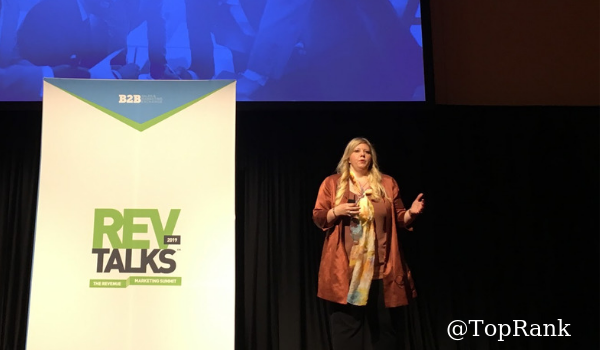
 What is the ultimate goal for any business or marketing unit? There are many valid answers to this question. But I think the subject of Maria Pergolino’s REVTalk on Tuesday morning at B2B Sales and Marketing Exchange (B2BSMX) in Boston offers a worthy aspiration for just about any organization: creating a category. Brands that are universally held in high esteem and pointed to as shining examples of marketing mastery – such as Uber, Salesforce, and Starbucks – often share this distinction. Their names ring synonymous with what they do. As a seasoned marketing executive who’s overseen this outcome at a number of different companies over the years, Maria has developed acute expertise on category creation, and offered us a glimpse of her process. Currently, she’s the Anaplan’s chief marketing officer. “I have lived in very fast-growth organizations,” she said, “and I want to talk about the marketing that has to be done for that to happen.”
What is the ultimate goal for any business or marketing unit? There are many valid answers to this question. But I think the subject of Maria Pergolino’s REVTalk on Tuesday morning at B2B Sales and Marketing Exchange (B2BSMX) in Boston offers a worthy aspiration for just about any organization: creating a category. Brands that are universally held in high esteem and pointed to as shining examples of marketing mastery – such as Uber, Salesforce, and Starbucks – often share this distinction. Their names ring synonymous with what they do. As a seasoned marketing executive who’s overseen this outcome at a number of different companies over the years, Maria has developed acute expertise on category creation, and offered us a glimpse of her process. Currently, she’s the Anaplan’s chief marketing officer. “I have lived in very fast-growth organizations,” she said, “and I want to talk about the marketing that has to be done for that to happen.”
Distinct, Comprehensive, Transformative
These three descriptors represent the standard for creating a category. Here’s how she frames each of them in practical terms. Distinct: You’ve got to be different. Any company that wants to own a category must necessarily be unique from all others within it. It’s not enough to be better; you have to be distinct. Comprehensive: Your company doesn’t need to do everything. It just needs to do everything that people want from a solution in your specific category. If you have gaps in addressing the needs and wants of your customers, you can bet your competitors will fill them. Transformative: There’s a misperception that every category-creator needs to reinvent the wheel. As Bandwidth’s Noreen Allen explained in her own “Built to Scale” REVTalk session later on Tuesday, it’s actually smart to join an established fast-growth market, so you can validate your vision with investors and gain resonance with customers. But as Maria implores, you need to transform that market or vertical in a meaningful way.Pillars of Category Creation
What makes category creation so exhilarating for marketers, in Maria’s mind? We have the opportunity to educate people. You’re not just regurgitating someone else’s talking points or reinforcing an existing paradigm. You’re charting a new course. Or, as she puts it, “You have a better way of doing something, and you’re trying to tell the world about it.” How do we break through with this original message, though? Maria provides a series of fundamental requirements, adding examples to illustrate.Establish the Brand
- Clear, Distinct & Stated
- Connects Audience
- Aligned to Product
- Repetition/Drumbeat
Build Demand
- Revenue, Not MQLs
- Scale
- A Shared Approach
- Metrics Based
Become the Leader
- Proven
- Innovative
- Network
- Trust
Align for Success
- Sales
- Product
- Human Resources
- Customer Success
Step by Step, Piece by Piece
One important thing to keep in mind is that creating a category isn’t an instantaneous process. It can be easy to look at a company like Uber and feel like their emergence took place overnight, but there was considerably more work and strategy behind this success. “Things that we see as trends, things that go viral, it takes a long time for that to happen,” Maria asserts. Luckily, thanks to her, we now have a blueprint in hand. Stay tuned for more live coverage of #B2BSMX Boston here on the TopRank Marketing Blog. In addition, follow along in real-time on Twitter at @NickNelsonMN and @leeodden.The post Seasoned CMO Maria Pergolino Charts the Path to Creating a Category appeared first on Online Marketing Blog - TopRank®.
Article Source: http://bathseoexpert.blogspot.com/2019/08/seasoned-cmo-maria-pergolino-charts.html
No comments:
Post a Comment